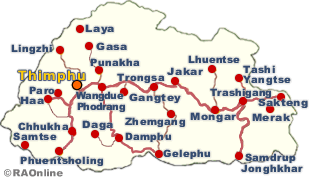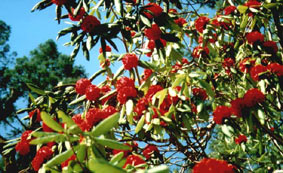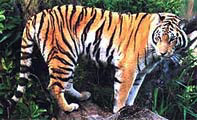 |
Bhutan's
Tourist Destinations |
|
 |
Bhutan Information |
|
|
 |
|
A
Botanical garden in Lamperi |
 |
| A Rhododendron garden with 46 species of the plant |
 |
 |
| A
Rhododendron garden with 46 species of the plant will be one of the themes
of a 125 acre botanical garden in Lamperi which will be ready by 2008 according to agriculture ministry officials.
"From
the 46 species 28 have already been planted," said project director, Raling
Ngawang Drukdra. "Eighteen of the species occur in the park area itself
while the rest are spread across the country." The park at Lamperi, 30
kilometres from Thimphu, will also have trekking routes, a walk around
the Baritsho Lake, a canteen, viewpoints and camping space for visitors. |
|
An
easy trekking route from the highway into the temperate rainforest and up to the highway near Baritsho has already been delineated.
The
route leads into a cool moist forest of huge oak, magnolia and birch
trees draped in moss that rings with the sound of birds and insects.
 |
| At
the end of the trekking route is the Baritsho which will
be drained, extended and treated for seepage control and made more striking
with ducks, lilies and a stone walk around it.
An
information centre and a pagoda overlooking the lake that will provide
"spectacular" views of the mountain ranges will be constructed. |
|
The
botanical garden is at the centre of a 47 square Royal Botanical Park which forms one of the critical biological corridors connecting the Jigme
Singye Wangchuck National Park and the Jigme Dorji Wangchuck National Park.
The
Lamperi area was declared a botanical park on April 13, 2005,
because of its rich ecosystem diversity. It has cool broad leaf forests,
mixed conifer forests, fir and sub-alpine forests and the temperate rain
forest with hundred of species of fauna.
 |
| Some
of the rare species found in the park are the monal pheasants, blood
pheasants, musk deer, tiger, leopard, red panda and the leopard cat,"
said the project director.
Campers
in the park will have to bring their own firewood or gas so that nothing
in the park is touched including the rotting logs which support insects
and worms. |
|
Trekking
through the garden on November 3, 2005, to inspect the progress of work
which began in March this year, Prime Minister Lyonpo Sangye Ngedup, said
that there should be minimum disruption to the environment and ecosystems.
"Any man made structures would have to be made in such a way that it does
not stand out and disrupt the natural image," he said. He also briefed
the project officials on the dos and don'ts that visitors should follow.
The
park, officials said, will be the first strict conservation area in Bhutan
and people will only be allowed to use the natural resources for environmental
purpose to promote sustainable use in other parts of the country.
The
total cost estimated for the first phase was Nu. 64 million. From the total,
Nu. 5.30 million has been granted by the Sustainable Development Secretariat
and Nu 5 million by the World Wildlife Fund.
 |
| Contributed
by KUENSEL, Bhutan's National Newspaper |
| Information on Bhutan |
 |
|





